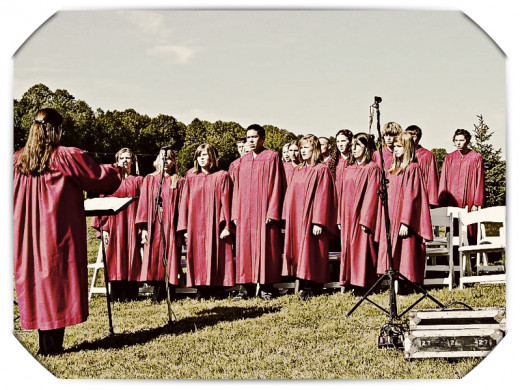How to start and lead a choir

By Michelle Liew Tsui-Lin
To you, which is the quality that makes a choir successful?
Amazing Grace- by a small male choir.
Voices in synchronized harmony are heard drifting from backstage, and the ideal choir appears in the spotlight.
The harmonic blend of music leads one to feel as though a host of winged angels has decided to make an appearance.
Forming a choir or group of singers such as this certainly takes a supreme effort and challenges that can leave any choir master or mistress tearing his other hair apart fro her musical scalp.
It is certainly no easy task to combine a medley of voices. It is a beautiful challenge, one which takes the laying of a good foundation and the bearing of a few considerations in mind.


The composition of a choir
The challenges in the way of forming a choir
For would be choir masters and mistresses who have never takn thie step step to form a choir on their own volition, or have been aske to start one, starting a choir means facing a few challenges that may b in he way. For the sake of one's passion for choral music, be easy to ace these obstacles squarely.
Finding the right voices
The first headache that settles its quite painful self on any choir master or mistress is the need to find the right blend of human voices.
It is already quite a struggle to find people who are patch perfect and have the ability to distinguish notes that form a harmonic chord. The environment one is in might not lend itself favorably to finding the right voices.
Then there is a matter of balance. The number of Sopranos might just overwhelm the Altos, or tenors and basses might be totally absent. I have experienced many occasions when males lack the confidence to sing in a choir because it was made up of too many girls.
Before starting a choir, it is good if one is in a situation where a balance of voices in good pitch can be achieved.
Leading the choir
One may be blessed with vocal and choral skills but mustering the bravery to lead the choir is yet another matter altogether.
Many conductors of youth or church have had no formal training in conducting, a necessary element needed before any choir can be started,It is always great to begin from that angle.
It is also a challenge to find someone who has the necessary musical skills, expertise and is willing to lead it in the first place!
Finding musicians
It is quite a hassle to lead a choir and play the piano or keyboard at once. Preferably, a regular pianist should be on hand to help intone the choir.
Voicing
Not everyone has the same singing ability. Intoning the choir can be a challenge to be overcome with a lot of patience.
Motivation
Persuading members of a choir to go through hours of rehearsals can leave the mouth dry. Choirs may suffer from low motivation because of a lack of members or long rehearsal hours.

Oh Happy Day - Sister Act 2
How to start a choir
There are many choirs based in churches and schools. Some are just ensembles of wonderful voices on their own.
Whatever choir there may be in mind to start, there are a few sometimes tedious processes that must be gone through. Starting a choir and getting it in shape is an endeavor that sometimes requires more than a little patience!
Talk about it.
Stir up interest and excitement about choirs wherever you may be. There will be people who would be interested in turning to singing as a form of relaxation. A music teacher in a school would take the opportunity to talk about it during lessons to generate interest among students if the aim is to start a choir in school.
Find the right person to lead the choir.
One may have the interest in starting a choir, but not the musical skills necessary to lead it. Ask around and find groups of people who would have these skills, for example, music teachers. Slowly thread towards to person with the appropriate skills and talents.
Have regular accompanists.
Having regular accompanists on the piano or even guitar would help greatly. Remember that even if a person both plays the piano and conducts well, they likely will not have the capacity to do both effectively, unless they are brilliant multi taskers. Having two people lead a choir is usually more effective.
Look for a quiet place to rehearse.
Preferably, this would be a soundproof music room, but if that is not available, look for a spot where the choir will not be disturbed while rehearsing. This would, of course, be a place where they would not disturb others either.
Make this a regular place to rehearse so that it becomes a matter of routine for all involved.
Focus on the process more than the product.
Of course, the goal of any choir would be to sing their absolute best during any performance. But there is something to be said about the processes of growth, learning and bonding.
Keeping it light and fun helps greatly in keeping members motivated to keep rehearsing. While it is important to grow and stretch the choir’s ability, choosing songs that are way beyond the capacity of members to sing and much less master harmony or other musical dynamics would throw them off immediately. Do not make scheduled performances too frequent, or the stress would serve to discourage.
Keep the cost low.
Try to find a space that does not cost anything to use for short periods of time. If the choir is on a tight budget, members of the same section in the choir may share scores. Think creatively of venues to perform. Concert venues in churches and schools would be free. If the choir is small and confident enough, a coffee house with a free concert venue may be considered. All that is needed is a little creative thinking!
I used to bring mine to Borders Bookstore in Singapore which was looking for Christmas Carollers. It gave the young members of our school’s largely inexperienced choir members exposure to performance and a chance to have some fun.
Bond!
While good musical ability definitely helps a choir to succeed, synergy is what makes a choir a real winner.
Members may be able to blend voices by virtue of technical expertise. However, the music sounds fuller and more connected when members can synergize. Emotional connections help them to emote as they are singing too.


Be sensitive to age range.
Grouping older adults, teens and younger children together in the same choir would likely turn out too much of a musical challenge. Notwithstanding that their musical tastes would be vastly different, their musical abilities would differ greatly too. Focus on a choir that centres on youth, adults or little children specifically.
That being said, there are times when a little experimentation, and patience, leads to the blending of 2 choral groups of different ages. Youth choirs have performed successfully with children’s choirs.
Auditioning
Think about what you would want the choir to achieve. If performances are for casual events such as Christmas Carolling or simple performances in schools and churches, there may not be a need to audition members.
If the targeted performances are high level, there would certainly be a need to audition for the more able singers.
If the choir has more able singers, these can be made to sing as a vocal group at special performances, or as soloists. Be careful to acknowledge the other members of the choir so as not to appear elitist.
itist or break any bonds. Preferably, all members should have a chance to take small solo portions of songs.
Identifiers!
Print logos and T shirts that would make the members feel part of the choral group and get them to wear these during rehearsals or casual performances.
The success of youth choirs hedges greatly on these. Teen choir members usually feel “cool” when they have an identifying tee shirt to wear.
Keep it different, yet the same
This, in a way, is similar to writing. have a range of songs that are familiar to members and practice them regularly.Bring them out for performances!
However, it is also important to infuse new content and get members used to singing pieces that are varied and different. The process of practice would be more refreshing.
Use different approaches to teach songs.
While sectionals are important, ‘la la la’ can be used to get members familiarized with the tune in general. This is true of younger children, who would need time to assimilate tunes.

Ode to Joy
Reminders on leading a choir
Prepare the song yourself before teaching it to others.
Being lost would make the choir lose a lot a confidence in not only yourself, but their own abilities too.
Make it manageable. Break the task, or song down into smaller parts or sections.
It really may not be possible for them to be able to master the entire song at one go.
Appoint section leaders.
They can help to teach the various sections their parts without them being left for too long. If necessary, hold separate sessions with them to get them familiarized with the parts first.
Give the choir a clear indication of what the starting notes of songs are.
Have a lead in so that the conductor and members know when to start singing.
Keep people informed of when sessions are.
People lose interest when they are uninformed about what is happening.
Devise fun and motivational warm ups!
Keep them at a regular, appropriate length. Remember that they will either be loved or hated and that it will not be possible to please everyone with them. But they are necessary for vocalization and development.


Conclusion
Building a choir is progressive, and there will be problems that are experienced by members of each section. But keeping it consistent, fun, fair and synergetic is the key to pointing a choir towards success.
Original work by Michelle Liew Tsui-Lin
All rights reserved.









